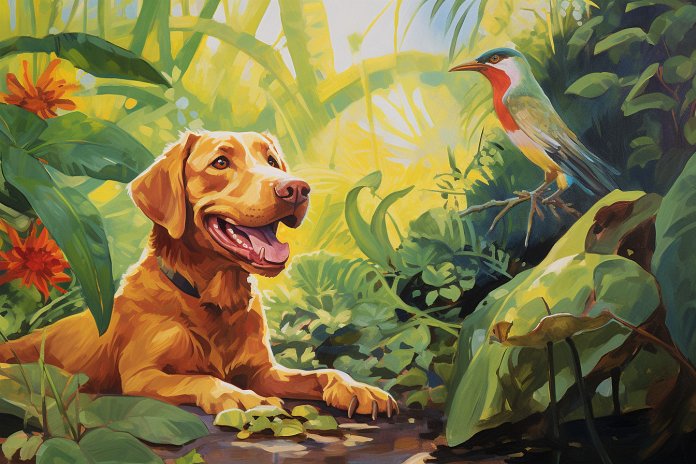
Reptiles and dogs are not often seen as friendly companions, but it is possible for them to live together. If you own a dog and are interested in having a lizard, you need to find a balance between the two species. In this article, we explore whether dogs can live with lizards.
Signs & Body Language to Look for When Dogs and Lizards are Together
When introducing a dog to a new animal, they may exhibit various body language signs. Sniffing and cautious licking are common signs to look for. If a dog is excited, they may nudge or paw at the lizard. It is not recommended to let the dog get too close to the lizard. Whining or barking can indicate a difficult adjustment for the dog.
A dog’s temperament plays a role in determining if they can live with a lizard. If the dog shows a strong interest in the lizard’s habitat, it may lead to accidents. Ideally, the dog should show no interest in the lizard.
Body Language
Here are some signs to watch for after introducing a lizard into the home: barking, whining, sniffing, licking, nudging, crouching, stalking, and chasing.
History of Dogs and Lizards
Lizards as pets are a relatively recent development. Responsible reptile ownership requires a lot of work due to their sensitivity to the environment. There is a limited history of dogs and lizards being kept as pets together. Dogs have never been used to track lizards and lizards are not typically a dog’s preferred prey.
Science of Dog and Lizard Interaction
The science behind dogs living with lizards involves instincts and sense of smell. Dogs are highly sensitive to new smells, and the presence of a lizard introduces new scents. Dogs’ instinct to eat small creatures like lizards may make it difficult for them to coexist. There is little research on how dogs perceive lizards or if their behavior is affected by the unique scent lizards produce.
Training Dogs to Live with Lizards
To train a dog to live with a lizard, they should already know basic commands like sit, stay, and come. Positive reinforcement through affirmation or treats is recommended. Aggressive behaviors towards the lizard should be immediately reprimanded. The ideal situation is for the dog to show no response to the lizard. Placing the lizard’s tank in a neutral area and keeping it out of the dog’s reach is important for safety.
Conclusion
While it is possible for dogs and lizards to live together, it requires careful observation of their body language and temperament. Dogs should not show excessive interest in the lizard’s habitat, and aggressive behaviors should be corrected. Training and proper placement of the lizard’s tank are important for a successful coexistence.
“In the delicate dance between dogs and lizards, understanding their body language and creating a secure environment is key.”

Tips & Things to Know
1️⃣ Observe the body language of your dog when introducing them to a lizard: When a dog is introduced to a lizard, look for signs such as sniffing and cautious licking. Avoid letting the dog get too close to the lizard if they show signs of excitement or fixation, as this may lead to accidents or aggression.
2️⃣ Consider your dog’s temperament: Dogs with destructive tendencies may not be suitable for living with a lizard. If your dog shows a strong interest in the lizard’s habitat and cannot leave it in peace, it may not be possible to have a lizard in your home. Look for no signs of the dog taking notice of the lizard as the best indicator for a successful cohabitation.
3️⃣ Train your dog and establish a secure environment: Train your dog to respond to commands such as sit, stay, and come. Use positive reinforcement to reinforce these commands. Discourage aggressive behaviors towards the lizard and position yourself as a neutral broker between the two creatures. Place the lizard’s tank in a neutral area of the house to avoid territorial issues, and ensure the lizard is out of the dog’s reach to prevent accidents. Do not leave the dog and lizard alone together due to the size difference and potential communicable diseases carried by lizards.
Frequently Asked Questions, Answered ✅
1. What are some signs of positive interaction between dogs and lizards?
– Sniffing and cautious licking
– Nudging with nose or paw (if the lizard is not contained)
– Looking into the tank or ignoring the lizard after sniffing it
2. What are some signs that a dog may not be able to live peacefully with a lizard?
– Whining or barking
– Overbearing interest in the lizard’s habitat
– Aggressive behaviors like growling or barking at the lizard
3. What is the history of dogs and lizards as domestic pets?
– Keeping lizards as pets is a recent development
– There is limited history of dogs and lizards living together
– Dogs have never been used to track lizards
4. What factors influence whether dogs can live with lizards?
– Dogs’ instinct to eat small creatures like lizards
– Dogs’ sensitivity to new smells introduced by lizards
– Limited research on how dogs conceive of lizards and their unique scent
5. How can dogs be trained to live with lizards?
– Dogs should have basic commands like sit, stay, and come mastered
– Positive reinforcement through vocal affirmation or treats is recommended
– Aggressive behaviors towards the lizard should be immediately reprimanded